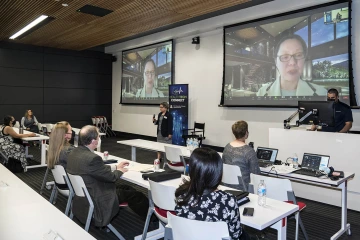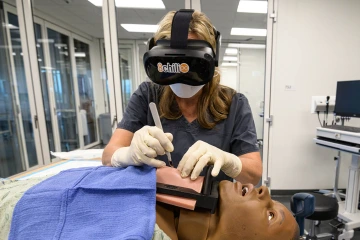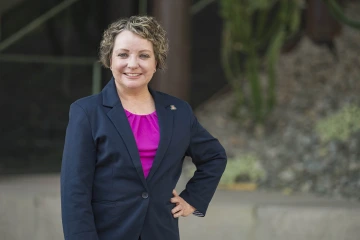Making Connections for a Healthier Future
A Health Tech Connect event fostered a partnership with a deep tech company that could help shape the future of medical simulation education.

Students and health professionals who undergo training at the Arizona Simulation Technology and Education Center may someday benefit from augmented reality thanks to a partnership facilitated by Health Tech Connect.
Long before the COVID-19 pandemic, the United States was facing a health care crisis. In 2020, the Association of American Medical Colleges estimated that by 2033, the country could see a shortage of 54,100 to 139,000 physicians. The pandemic years have added further strain and stretched the problem even wider, significantly affecting other health care professions.

Navin Gavind, chief growth officer for 8chili, said having an office location in Phoenix and being connected to the University of Arizona Health Sciences makes for a “perfect partnership.”
Health Tech Connect is building a network of start-up, corporate, higher education, funding and economic development stakeholders to advance health technology in Arizona.
“The idea is to break down the walls, eliminate the silos and get everyone in the same room,” said Caroline Berger, director of corporate and community relations for UArizona Health Sciences.
In September 2021, Health Tech Connect hosted its first quarterly event at the Phoenix Bioscience Core. Speaker presentations were followed by a reception geared toward networking opportunities for the attendees.
“Phoenix is a real hotbed and people wanted to see what our university was doing, especially in biotechnology,” Berger said. “They wanted a reason to connect and spotlight the health sciences, and along with our community partners, I think we were able to provide that.”
A good catalyst for connection
Navin Govind, chief growth officer for the deep tech company 8chili, was one of the presenters at the initial Health Tech Connect event. He recalls conversations on the patio in the networking session that ultimately sparked a relationship between the company and the university.

Caroline Berger spoke at the December 2021 Health Tech Connect event, which included both in-person and virtual participants.
“8chili was formed to address challenges in what we call the health ‘metaverse.’ The event was a good catalyst for us,” Govind said. “It put 8chili at the forefront and a number of conversations have spiraled into more conversations that we’re continuing to pursue.”
Govind said the shortage of health care workers, exacerbated by the pandemic, created the opportunity for 8chili to partner with an academic medical center. The company was seeking new markets for its HintVR™, a robust platform that utilizes headsets and a cloud-enabled management system to produce virtual, mixed and augmented reality simulations.
Govind first met with Jim Lindgren, MD, medical director for the Center for Simulation and Innovation at the UArizona College of Medicine – Phoenix. Govind toured the center and was impressed with both what he saw and the potential it had for 8chili.

Suturing is one of four training modules 8chili will develop for researchers at ASTEC. Allan Hamilton, MD, FACS, (left) is one of the subject matter experts reviewing 8chili’s products.
“Jim has built out a wonderful, very capable set of tools that he's put together on the virtual reality side to enable the next generation of simulation learning,” Govind said. “We talked about how to close the gaps between COVID-induced problems with remote collaboration – with learning – and how to introduce new modalities.”
In Phoenix, the budding relationship sparked by Health Tech Connect led to 8chili opening an office at the Weartech Applied Research Center. The Greater Phoenix Economic Council also got involved by providing a funding opportunity to help foster a partnership between UArizona Health Sciences and 8chili.
Govind later visited the Arizona Simulation Technology and Education Center (ASTEC) in Tucson, where he met with Allan Hamilton, MD, FACS, ASTEC’s executive director, and Dave Biffar, MS, CHSOS-A, assistant director of operations. From that meeting, formal agreements for reviewing and developing products to be used in medical simulation were developed.
“I was just blown away by ASTEC,” Govind said. “I told them that this is we where we want to collaborate with you, because you are building something very unique.”
Mutually beneficial and promising potential
As part of the agreement between the two parties, ASTEC is providing subject matter experts, including Dr. Hamilton, to test the HintVR™ platform. After the experts have completed their review, ASTEC will provide a final report back to 8chili. In return, 8chili is developing four training modules for ASTEC based on procedures for IV placement, suturing, cricothyrotomy and lumbar puncture.

The first module 8chili is working to develop could enhance training for the cricothyrotomy procedure, which is an incision to the neck to open an airway.
“I remain optimistic about the potential of the 8Chili training platform,” Biffar said. “From what I've seen already, there is promise for incorporating mixed reality technology into some of our training modules.”
Biffar believes augmented reality can be especially useful for the students and health professionals who undergo training at ASTEC.
“The procedural models we create are pretty realistic,” Biffar said. “But some of our subject matter experts would like to see additional features like a whoosh of air or a spray of blood, which could be easily incorporated using the 8Chili technologies”
The first module 8chili will develop will be the cricothyrotomy procedure, which involves making an incision in the neck to establish an airway during certain life-threatening situations.

As director of corporate and community relations for UArizona Health Sciences, Caroline Berger organizes quarterly Health Tech Connect events that seek to bring key stakeholders together to advance health care technology.
“This kind of virtual training experience may help to provide a sorely needed fix to help fill the gap in the procedural competence of some of our residents,” said Dr. Hamilton, a Regents Professor in Surgery who trained as a brain surgeon at Harvard University. “The average resident may go through their whole postgraduate training and never perform a cricothyroidotomy.
“Everyone has big hopes and expectations about the future of VR, but we also need to make sure the technology gets adequately vetted by clinicians who routinely do the procedures,” Dr. Hamilton added. “ASTEC can provide a very deep bench of subject matter experts and we have the facilities and personnel to ensure that, once the time is right, we can adequately assess its potential in the hands of some very motivated young doctors and nurses.”
Contact
Blair Willis
520-626-2101
bmw23@arizona.edu

